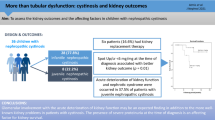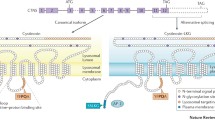Abstract
Background and objectives
Nephropathic cystinosis is a lysosomal storage disorder characterized by renal tubular Fanconi syndrome in infancy and glomerular damage leading to renal failure at ∼10 years of age. Therapy with the cystine-depleting agent cysteamine postpones renal failure, but the degree of compliance with this treatment has not been correlated with preservation of kidney function.
Methods
We assessed leucocyte cystine depletion by cysteamine and created the composite compliance score that incorporates the extent of leucocyte cystine depletion, as well as duration of cysteamine treatment, into a single integer. Age at renal failure was used to gauge preservation of renal function, and the Fanconi syndrome index (FSI), a measure of aminoaciduria, was used to assess renal tubular Fanconi syndrome.
Results
Age at renal failure varied directly and linearly with the composite compliance score (y = 0.3x +8.8; R2 = 0.61). The slope indicated that for every year of excellent cystine depletion, nearly 1 year of renal function was preserved. Age at renal failure correlated roughly with mean leucocyte cystine level, but not with mean cysteamine dosage. There was no correlation between the FSI and the composite compliance score.
Conclusions
Greater compliance with oral cysteamine therapy yields greater preservation of renal glomerular, but not tubular, function. Oral cysteamine therapy should be given at the maximum tolerated dose, within the recommended limits.




Similar content being viewed by others
References
Gahl WA, Bashan N, Tietze F, Bernardini I, Schulman JD (1982) Cystine transport is defective in isolated leukocyte lysosomes from patients with cystinosis. Science 217(4566):1263–1265
Gahl W, Thoene J, Schneider J (2002) Cystinosis. N Engl J Med 347:111–121
Gahl WA, Thoene J, Schneider JA (2001) Cystinosis: a disorder of lysosomal membrane transport. In: Scriver CR, Beaudet AL, Sly WS, Valle D, Childs B, Kinzler KW, Vogelstein B. The metabolic and molecular basis of inherited disease. McGraw-Hill Companies, Inc., Eighth Edition, pp. 5085–5108. Online Update, 2013
Nesterova G, Gahl W (2008) Nephropathic cystinosis: late complications of a multisystemic disease. Pediatr Nephrol 23(6):863–878
Town M, Jean G, Cherqui S, Attard M, Forestier L, Whitmore SA, Callen DF, Gribouval O, Broyer M, Bates GP, van’t Hoff W, Antignac C (1998) A novel gene encoding an integral membrane protein is mutated in nephropathic cystinosis. Nat Genet 18:319–324
Kalatzis V, Cherqui S, Antignac C, Gasnier B (2001) Cystinosis, the protein defective in cystinosis, is a H+-driven lysosomal cystine transporter. EMBO J 20:5940–5949
Nesterova G, Gahl W (updated 2014) Cystinosis, Genereviews website: (www.ncbi.nlm.nih.gov)
Wilmer M, de Graaf-Hess A, Blom H, Dijkman H, Monnens L, van den Heuvel L, Levtchenko E (2005) Elevated oxidized glutathione in cystinotic proximal tubular epithelial cells. Biochem Biophys Res Commun 337(2):610–614
Manz F, Gretz N (1994) Progression of chronic renal failure in a historical group of patients with nephropathic cystinosis. European Collaborative Study on Cystinosis. Pediatr Nephrol 8(4):466–471
Middleton R, Bradbury M, Webb N, O’Donoghue D, Hoff W (2003) Cystinosis. A clinicopathological conference. “From toddlers to twenties and beyond” Adult-Paediatric Nephrology Interface Meeting, Manchester 2001. Nephrol Dial Transplant 18:2492–2495
Mahoney C, Striker G (2000) Early development of the renal lesions in infantile cystinosis. Pediatr Nephrol 15(1–2):505–506
North American Pediatric Renal Trials and Collaborative Studies. NAPRTCS 2008 Annual Report. (Accessed May 2009).
Gahl W, Reed G, Thoene J, Schulman J, Rizzo W, Jonas A, Denman D, Schlesselman J, Corden B, Schneider J (1987) Cysteamine therapy for children with nephropathic cystinosis. N Engl J Med 316(16):971–977
Thoene JG, Oshima RG, Crawhall JC, Olson DL, Schneider JA (1976) Cystinosis. Intracellular cystine depletion by aminothiols in vitro and in vivo. J Clin Investig 58:180–189
Markello T, Bernardini I, Gahl W (1993) Improved renal function in children with cystinosis treated with cysteamine. N Engl J Med 328:1157–1162
Nesterova G, Gahl W (2013) Cystinosis: the evolution of a treatable disease. Pediatr Nephrol 28(1):51–59
Charnas L, Bernardini I, Rader D, Hoeg J, Gahl W (1991) Clinical and laboratory findings in the oculocerebrorenal syndrome of Lowe, with special reference to growth and renal function. N Engl J Med 324(19):1318–2135
Oshima R, Willis R, Furlong C, Schneider J (1974) Binding assays for amino acids. The utilization of a cystine binding protein from Escherichia coli for the determination of acid-soluble cystine in small physiological samples. J Biol Chem 249:6033–6039
Worster A, Fan J, Ismaila A (2007) Understanding linear and logistic regression analyses. CJEM 9(2):111–113
Park M, Helip-Wooley A, Thoene J (2002) Lysosomal cystine storage augments apoptosis in cultured human fibroblasts and renal tubular epithelial cells. J Am Soc Nephrol 13:2878–2887
Long W, Seashore M, Siegel N, Bia M (1990) Idiopathic Fanconi syndrome with progressive renal failure: a case report and discussion. Yale J Biol Med 63(1):15–28
Gretz N, Manz F, Strauch M (1983) Predictability of the progression of chronic renal failure. Kidney Int Suppl 15:S2–S5
van’t Hoff WG, Ledermann S, Waldron M, Trompeter R (1995) Early-onset chronic renal failure as a presentation of infantile nephropathic cystinosis. Pediatr Nephrol 9(4):483–484
Gahl W, Tietze F, Butler J, Schulman J (1985) Cysteamine depletes cystinotic leucocyte granular fractions of cystine by the mechanism of disulphide interchange. Biochem J 228(3):545–550
Pisoni R, Thoene J, Christensen H (1985) Detection and characterization of carrier-mediated cationic amino acid transport in lysosomes of normal and cystinotic human fibroblasts. J Biol Chem 260:4791–4798
Gahl W, Balog J, Kleta R (2007) Nephropathic cystinosis in adults: natural history and effects of oral cysteamine therapy. Ann Intern Med 147:242–250
Kleta R, Gahl W (2004) Pharmacological treatment of nephropathic cystinosis with cysteamine. Expert Opin Pharmacother 5(11):2255–2262
Gahl W, Schneider J, Schulman J, Thoene J, Reed GF (1990) Predicted reciprocal serum creatinine at age 10 years as a measure of renal function in children with nephropathic cystinosis treated with oral cysteamine. Pediatr Nephrol 4(2):129–135
Ludwig M, Sethi S (2011) Novel techniques and newer markers for the evaluation of “proximal tubular dysfunction”. Int Urol Nephrol 43(4):1107–1115
Papadopoulos N, Costello R, Charnas L, Adamson M, Gahl W (1987) Electrophoretic examination of proteinuria in Lowe’s syndrome and other causes of renal tubular Fanconi syndrome. N Engl J Med 316(16):971–977
Kleta R, Bernardini I, Ueda M, Varade W, Phornphutkul C, Krasnewich D, Gahl W (2004) Long-term follow-up of well-treated nephropathic cystinosis patients. J Pediatr 145(4):555–560
Baum M (1998) The Fanconi syndrome of cystinosis: insights into the pathophysiology. Pediatr Nephrol 12:492–497
Author information
Authors and Affiliations
Corresponding author
Rights and permissions
About this article
Cite this article
Nesterova, G., Williams, C., Bernardini, I. et al. Cystinosis: renal glomerular and renal tubular function in relation to compliance with cystine-depleting therapy. Pediatr Nephrol 30, 945–951 (2015). https://doi.org/10.1007/s00467-014-3018-x
Received:
Revised:
Accepted:
Published:
Issue Date:
DOI: https://doi.org/10.1007/s00467-014-3018-x




